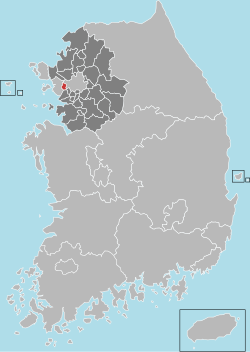Bucheon
부천시 | |
|---|---|
| Korean transcription(s) | |
| • Hangul | 부천시 |
| • Hanja | 富川市 |
| • Revised Romanization | Bucheon-si |
| • McCune–Reischauer | Puch'ŏn-si |
 City Hall | |
 | |
| Coordinates: 37°30′N 126°47′E / 37.500°N 126.783°E | |
| Country | |
| Region | Gyeonggi Province (Sudogwon) |
| Administrative divisions | 10 dong |
| Government | |
| • Mayor | Cho Yong-ik (Democratic) |
| Area | |
| • Total | 53.44 km2 (20.63 sq mi) |
| Elevation | 16 m (52 ft) |
| Population (September 2024[1]) | |
| • Total | 772,450 |
| • Density | 16,660.78/km2 (43,151.2/sq mi) |
| • Dialect | Gyeonggi |
| Postal code | 14400-14899 |
| Area code | (+82)-32-6xx |
| Website | www.Bucheon.go.kr (in English) |
Bucheon (Korean: 부천; Korean pronunciation: [pu.tɕʰʌn]) is a city in Gyeonggi Province, South Korea. Bucheon is located 25 kilometers (16 mi) away from Seoul, of which it is a satellite city.[2] It is located between Incheon and Seoul.
Bucheon is the second most densely populated city in South Korea after Seoul,[3] and as a result, administrative districts were abolished in July 2016 in favor of providing greater public service in community centers.[3]
Major manufacturing operations are located in the northern areas of the city, while the areas in the south where Seoul Subway Line 7 and Seoul Subway Line 1 pass are dense commercial and residential areas.
- ^ "Population statistics". Korea Ministry of the Interior and Safety. 2024.
- ^ Hae Un Rii, Jae-Seob Ahn. Ian Douglas, Shu-Li Huang (ed.). 3.Urbanization and its Impact on Seoul, Korea (PDF). Urbanization, East Asia and Habitat II. Taiwan NGO Professionalization Watch. Archived from the original (PDF) on 2014-06-30. Retrieved 2016-02-17.
- ^ a b 부천시, 상동 영상단지 내 초대형 신세계 복합쇼핑몰 건립 '논란'… 시민단체 '반발'. 16 May 2016.
